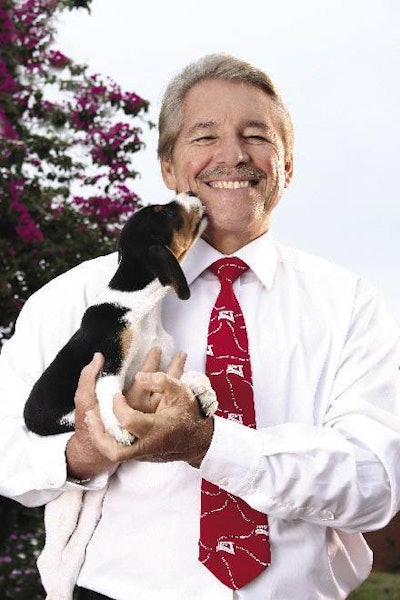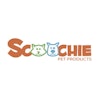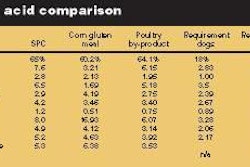
The state of the global petfood industry is positive. I am optimistic," declares Antonio Teixeira de Miranda, president of Total Alimentos SA in Brazil. "There are terrific prospects and tough challenges ahead," he observes. "I think the petfood market is ready to continue strong growth in emerging and mature markets."
Euromonitor International echoes Mr. Miranda's assessment. Their report, The World Market for Petfood and Pet Care Products, predicts global sales of dog and cat foods will grow from US$42 billion to US$48 billion from 2005 to 2010. (Go to www.petfoodindustry.com for a link to Euromonitor's petfood reports.)
Petfood Industry magazine recently asked several industry leaders to answer questions about the petfood industry. Here is some of what they had to say. Editor's note: Comments from the European petfood manufacturers' trade association (FEDIAF) were not available at press time.
Safety & trade barriers
Antonio Teixeira de Miranda, Total Alimentos, SA
In addition to being president of Total, Antoinio Teixeira de Miranda is the immediate past chair of the Brazilian petfood manufacturers' trade association (ANFAL). He believes that, "the petfood industry has two big challenges:
Providing the true petfood safety expected by pet owners; and
Eliminating commercial barriers designed to protect certain petfood markets. They are often justified under the guise of food safety."
"R&D has made positive changes possible in the quality of petfood ingredients, products and packaging," says Miranda. "However, huge investments must be made in training, building the correct layout and buying equipment, in order to meet the demand for safe and consistent petfoods. In addition, we are faced with specific restrictions, such as GMO-free and ruminant-free."
Miranda went on to predict, "new petfood facilities will be needed to replace many of the existing ones. There is no way to follow the GMP and HACCP rules without the correct layout, equipment and building construction. The petfood industry is moving towards human food standards. Petfoods will increasingly be marketed side by side with people food."
He points out that, "we worked hard to implement international GMPs, HACCP and ISO 9000. We have focused on safety for our employees and our products. Since 1995, we invested in new technologies such as co-extrusion, pillow pack products, unique snacks and adding meat and milk ingredients. However, during the last four years our company has focused on the food safety challenge so that we can export worldwide."
Finally, Miranda asserts that, "commercial barriers based on sanitary restrictions are our company's most difficult challenge."
Improving the industry
Robert Wheeler, Hill's Pet Nutrition
Robert Wheeler is the CEO of Hill's Pet Nutrition and the current chair of the US Pet Food Institute's Board of Directors. He points out that, "PFI's relationships with regulators, other associations and the media have helped solve a variety of petfood industry problems. For example, PFI has helped the industry deal with the discovery of BSE cases in the US and the growing worries over avian influenza."
He notes that, "the association has also been successful in moving forward the use of new petfood ingredients. We recently hosted an unprecedented summit with FDA and others on the regulatory approval and use of novel materials."
Wheeler tells Petfood Industry that, "at the state level, PFI has fought petfood taxes. Internationally, PFI continues to improve the trade environment for members. Trade barriers, particularly sanitary and phytosanitary barriers, that are almost always unjustified, have continued to impact everyone with international operations."
Dealing with misinformation
He thinks, "petfood industry issues grow more complex every year. Dealing with misinformation spread by some groups continues to be one of PFI's greatest challenges. I don't see that diminishing anytime soon. In addition, the growing internationalization of the petfood industry continues to pose challenges. PFI members do business in scores of countries and are always looking for new markets. Emerging economies in Asia, particularly China and Eastern Europe, continue to put great demands on PFI to facilitate fair trade. PFI has an increasingly important role in speaking for the industry with a strong, unified voice."
Wheeler asserts, "the industry has been going through some tumultuous changes." He believes, "the best way I see to help PFI during my tenure as its chairman is to assure we continue working together constructively to address industry issues that impact us all. It's my responsibility to persuade my fellow industry leaders to encourage their staff to actively participate in PFI committees. It's good for them to be involved and critical to the success of the association."
He points out that, "the petfood industry is highly competitive and dynamic. There has been a spate of consolidations lately but at the same time we see a continual influx of new companies finding highly successful niches. Across the world people are realizing the enjoyment pet ownership brings. As a rising middle class comes into being in many developing countries, I expect to see a growth in both pet ownership and petfood use. I also think we will see the pace of product innovation continue. As we learn more about the benefits of good nutrition, I think we will see an increase in products designed to keep pets healthy and help those with problems."
Wheeler sums up by saying, "PFI is well positioned to continue being an effective advocate for its members. There is a lot of hard work ahead, so I encourage your readers to get more involved with PFI."
R&D speed
George Collings, PhD, consultant
Dr. Collings is currently president of Collings Nutrition Solutions. He was recently with AFB as VP of Science & Technology. Before that, he was the VP of Research & Development at Sunshine Mills, director of Nutrition at Hill's Pet Nutrition and research manager at Ralston Purina.
Dr. Collings notes that the petfood industry has gone through many phases since he first became involved in petfood product development in 1979. He states that, "the great majority of manufacturing is now directed by less than 25 companies around the world with fewer and fewer retail options."
New items with a health focus
Collings points out that, "today's consumer continually wants new items with a health focus for their pet. If the owners get variety in their own diet, their pet should get variety too. Years ago, a brand would have a handful of line extension products being mindful of product turnover and shelf life. A brand in today's market can have several line extensions, some with a low turnover. In addition, competition is quick to respond with their own version of any unique product, adding to the sea of products in most stores."
He asserts that, "the speed of product development is more important than ever. This push for new products has led to an enormous increase in patent applications to keep a competitive advantage. It is more difficult today for small companies to bring an innovative concept to market, although some have."
Collings predicts that, "we will see a steady growth in the supplement and treat markets for pets. There will also be a major push towards products that are made with ingredients used in human foods. Packaging appearance will continue to improve and products will become more appealing to the human eye.
From a production point of view, he believes, "we will see more manufacturing done outside the US to reduce the overall cost of goods." He notes that, "it has been years since a new technology like extrusion or canning has entered the marketplace. I believe that a new processing technology could be on the ten-year horizon opening up multiple new product concepts."
He thinks that, "over the last 15 years, some good ingredients have been vilified for marketing reasons. As the number of ingredient options decline, the chance of developing successful products also declines. In addition, product concepts with unique ingredients lead to plant and manufacturing complexity and higher costs. For example, almost all products today must be stabilized with natural preservative systems for marketing reasons. Stabilizing products naturally for a 12-18 month shelf life is one of the most difficult product development tasks today."
Finally, Collings states that, "regulatory variability between countries is high. This causes trade problems and product transfer between countries. It adds to package inventories and labeling conflicts."
Growing and healthy
John Kuenzi, CJ Foods
John Kuenzi is the owner and president of CJ Foods, Inc., a custom producer and packager of extruded animal and companion pet diets. Its plants are located in Pawnee City, Nebraska and Bern, Kansas, USA.
Kuenzi believes that, "both the US and global markets are growing and healthy. The US petfood market is still one of the few manufacturing industries where US manufacturers have a significant and defendable competitive advantage. We owe this to the closeness of our raw materials, economy of scale and a mature yet growing petfood market."
Kuenzi predicts, "the large number of acquisitions over the last few years will likely continue, typically in response to movement by other players. Companies are meeting strategic objectives by purchasing businesses that maximize brand positions." He also predicts:
"Like all industries, the petfood business has and will continue to change as a result of globalization. Several forces are leveling the global playing field.
The US market will continue to see an increase in all-natural and organic diets, functional foods with specific health benefits and unique products that promote the human-animal bond. Humanization of dogs and cats will also continue to spread.
Convenient packages for a lifestyle on-the-go will play an increasing role.
Supply chain and data management will become critical.
Product development will change to a more open model with an increase in outside ideas being commercialized internally through acquisition and royalty agreements."
Talking about CJ Foods' recent accomplishments, he says, "in 2002 we brought our new Bern, Kansas facility on line with some unique processing systems. We now have some special capabilities. We continue to focus on efficiency with company-wide lean initiatives, comprehensive supply chain management, innovative technology, training and other programs.
He cites these challenges:
Heightened scrutiny of product quality due to consumer issues.
Energy and logistics costs have made it difficult to maximize profitability.
An ever-increasing regulatory burden which adds cost with little perceived value to the consumer.
Kuenzi sums up with, "the speed of change is probably the hardest thing to handle. Making good decisions in the face of rapid change is a constant challenge."


















